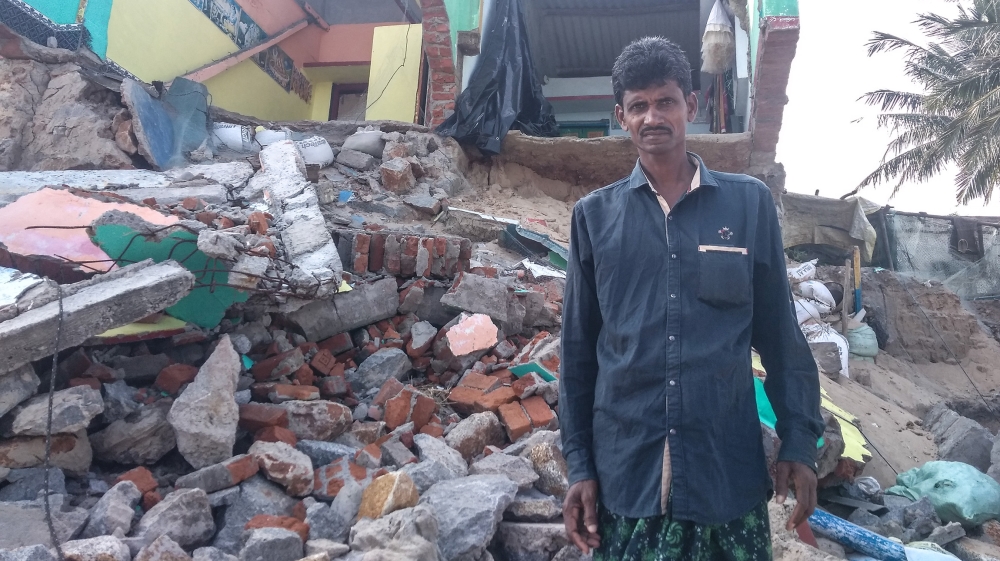
Odisha, India - There is hardly any sign of rain in Ramayapatana, a coastal village in the east Indian state of Odisha, and fishermen are preparing to take their traditional, hand-operated boats out to sea.
Having wreaked havoc on the village recently, the sea on this October day is calm enough to venture out.
But Landa Loknath, a 45-year-old fisherman and father of three, will not be joining the group.
He is too busy trying to find a new location for a home and organise funds for construction.
Severe coastal erosion has demolished his home. Two rooms and the main entrance of his house were swallowed by the sea when the monsoon onslaught hit the Indian coast in June.
"Sand bags or erosion control bags couldn't save my house from the high and strong waves," he told Al Jazeera. "In a single moment, a huge and strong wave, almost eight metres high, entered into my house from the front door and swallowed two front rooms.
"It was horrible experience for all of us. Along with my house, 27 others in our village were swallowed by the waves."
As he walked up a steep broken wall covered in sand bags, he explained, "It was a wake-up call for the 3,000 villagers.
"Sea erosion will take place elsewhere … This time, we just happen to be the first."
As the sea nears the village, drinking water has become scarce.
Tube well water, considered to be safe to drink in rural parts of Odisha and across India, has become saline.
Locals now have to walk almost one kilometre (0.62 miles) to draw drinking water from a nearby village.
"The sea waves coming closer to our village have made our life miserable. We no longer use tube well water for drinking … only to wash utensils, clothes and for other household use," said Gitulasama, a housewife.
She now lives next to her in-laws after her own house was destroyed by rising sea levels, which caused soil erosion.
"The tube wells in the village, that were about half a kilometre from the sea, [have deteriorated and the] water has become saline in last six months."
"It has now become a daily exercise for [us women] to walk for 10-12 minutes twice or sometimes three times a day to fetch drinking water from a nearby well in the adjoining village," Gitulasamasaid. "I would have married to someone else, if I would have known that such a situation would arise."
The first sign of disaster came in 2009, when a tidal surge hit the village and took away a concrete road built on the coast.
In July and August, accelerating erosion severly damaged a community hall, which was built at an estimated cost of 1.4 million rupees ($19,693.21) on the edge of the coast.
Odisha's biodiversity is unique. From next month, Olive Ridley sea turtles will start their annual migration for mating and nesting along the Odisha coast. The state is also home to Chilika Lake, the largest coastal lagoon in India and the world's second-largest brackish water lagoon after The New Caledonian barrier reef.
A study released in July last year by the National Centre for Coastal Research said Odisha lost 153.8 kilometres (95.6 miles), or 28 percent, of its 485km (301 miles) coastline between 1999 and 2016, to sea water ingression.
Some experts say climate change has made about 10 percent of Odisha's coastline highly vulnerable to sea erosion, claiming that besides natural processes that affect shoreline changes, human behaviour in the coastal zone have added another dimension.
"Odisha's coastline is severely affected due to sea soil erosion. Increasing sea-level, climate change and man-made disasters are behind such accelerating soil erosion. What Ramayapatana has witnessed is a natural course of action of the sea … due to destruction of sand dunes," said Jagannath Bastia, president of the Beach Protection Council of Odisha.
"But Kendrapara's and Puri's coastal areas - it's man-made disaster," he said, referring to a town and city in Odisha, respectively.
"This is because of sand-mining, often illegal, that poses threat to the coastal areas, sand dunes, to the ecology,"
Standing at the partially uprooted community hall in Ramayapatana, local fisherman L Bhogra said despite the damage, "none of the villagers have abandoned the village.
"In fact, [those who lost houses] have moved in the houses of relatives and close friends. We [fishermen] cannot live without the sea. Our life depends on the wealth that the sea offers to us. Sea is our mother and father."
He said fisherman would struggle to survive in cities, because they do not have experience or training in industries such as construction, real estate or hospitality.
Some villagers had planned to move to a state-funded rehabilitation centre set up in 2018 by the Odisha Disaster Recovery Project (ODRP), which offered alternative housing.
The houses were located about 1.5km (0.9 miles) from Ramayapatana village, but many villagers changed their minds because of the lack of space.
ODRP had promised locals a 240sq-foot (22.3sq-metre) home if they were able to prove their own home was the same size, but most had enjoyed larger residences.
"How can a family of five live in a house of 240sq feet?" said Bhogra. "Tomorrow, if my son marries, I won't be in a position to offer him a single room for the purpose of his privacy. So what's the use in moving to a congested house, where nobody would have freedom of space."
The Odisha government said it has adopted several measures to counter the coming threat of climate change.
"On October 21, a technical team - the Integrated Coastal Zone Management Project (ICZMP), a World Bank-supported project, visited the village," said Kishore Tripathy, an ICZMP engineer who led the group.
In an attempt to control severe sea soil erosion, ICZMP recommends the construction of a three-metre (10-foot) high, one-kilometre long concrete wall across the boundary of village houses facing sea.
But villagers, including Bhogra, are sceptical, having witnessed the damage inflicted by rising sea levels.
"We have heard that the government is planning to construct a long and strong guard wall near the beach to protect our village," he said. "The sea wall may reduce the risk of wave entering our houses and land erosion, but I don't think there is any device made by humans that would be able to control and capture the energy of ocean waves."







